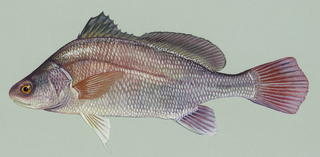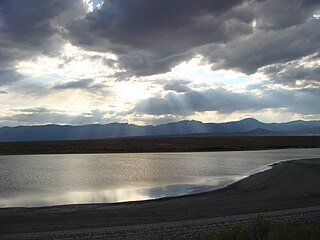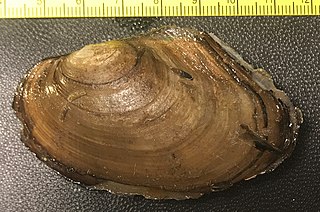
Mussel is the common name used for members of several families of bivalve molluscs, from saltwater and freshwater habitats. These groups have in common a shell whose outline is elongated and asymmetrical compared with other edible clams, which are often more or less rounded or oval.

The quagga mussel is a species of freshwater mussel, an aquatic bivalve mollusk in the family Dreissenidae. It has an average lifespan of 3 to 5 years.

The freshwater drum, Aplodinotus grunniens, is a fish endemic to North and Central America. It is the only species in the genus Aplodinotus, and is a member of the family Sciaenidae. It is the only North American member of the group that inhabits freshwater for its entire life. Its generic name, Aplodinotus, comes from Greek meaning "single back", and the specific epithet, grunniens, comes from a Latin word meaning "grunting". It is given to it because of the grunting noise that mature males make. This noise comes from a special set of muscles within the body cavity that vibrate against the swim bladder. The purpose of the grunting is unknown, but due to it being present in only mature males and during the spawning season, it is assumed to be linked to spawning.

The Pajaro River, is a U.S. river in the Central Coast region of California, forming part of the border between San Benito and Santa Clara Counties, the entire border between San Benito and Santa Cruz County, and the entire border between Santa Cruz and Monterey County. Flowing roughly east to west, the river empties into Monterey Bay, west of Watsonville, California.

The depressed river mussel or compressed river mussel, Pseudanodonta complanata, is a species of freshwater mussel, an aquatic bivalve mollusk in the family Unionidae, the river mussels. The species name comes from the flattened shape of its shell.

Anodonta is a genus of freshwater mussels in the family Unionidae, the river mussels.

The duck mussel is a species of freshwater mussel, an aquatic bivalve mollusk in the family Unionidae, the river mussels.

The swan mussel, Anodonta cygnea, is a large species of freshwater mussel, an aquatic bivalve mollusc in the family Unionidae, the river mussels.

Sinanodonta woodiana, the Chinese pond mussel, Eastern Asiatic freshwater clam or swan-mussel, is a species of freshwater mussel, an aquatic bivalve mollusk in the family Unionidae, the river mussels.

Unionida is a monophyletic order of freshwater mussels, aquatic bivalve molluscs. The order includes most of the larger freshwater mussels, including the freshwater pearl mussels. The most common families are the Unionidae and the Margaritiferidae. All have in common a larval stage that is temporarily parasitic on fish, nacreous shells, high in organic matter, that may crack upon drying out, and siphons too short to permit the animal to live deeply buried in sediment.

The brook floater, Alasmidonta varicosa, is a species of freshwater mussel, an aquatic bivalve mollusk in the family Unionidae, the river mussels. It measures 25.1 mm to 80.2 mm in length although other research also suggests it rarely exceeds three inches (75 mm).
Freshwater bivalves are one kind of freshwater mollusc, along with freshwater snails. They are bivalves which live in freshwater, as opposed to saltwater, the main habitat type for bivalves.

Curlew Lake is a 921-acre (3.73 km2) lake located in the glacier-carved Curlew Valley northeast of Republic, Washington. The spring- and stream-fed lake is named for the long-billed curlew, Numenius americanus, that once frequented the area. The 7-mile-long (11 km) lake reaches a maximum of 1⁄3 miles wide and includes four small islands.

Pruess Lake is a small spring-fed lake in Snake Valley, Millard County, west-central Utah, United States. It is just south of Garrison and north of Burbank. It was named after Charles Preuss, a cartographer who was on John C. Fremont's first, second and fourth expeditions. Where or when the spelling error occurred is unknown, but all maps and official state naming documents mention the lake's name as Pruess. The area of the lake is about one square mile.

Hinge teeth are part of the anatomical structure of the inner surface of a bivalve shell, i.e. the shell of a bivalve mollusk. Bivalves by definition have two valves, which are joined together by a strong and flexible ligament situated on the hinge line at the dorsal edge of the shell. In life, the shell needs to be able to open slightly to allow the foot and siphons to protrude, and then close again, without the valves moving out of alignment with one another. To make this possible, in most cases the two valves are articulated using an arrangement of structures known as hinge teeth. Like the ligament, the hinge teeth are also situated along the hinge line of the shell.

Anodonta cataracta, the eastern floater, is a species of large freshwater mussel, an aquatic bivalve mollusc in the family Unionidae, the river mussels.
Anodonta pseudodopsis is a species of medium-sized freshwater mussel, an aquatic bivalve mollusc in the family Unionidae, the river mussels.

Pyganodon lacustris is a species of freshwater mussel, an aquatic bivalve mollusk in the family Unionidae, the river mussels. It is endemic to the United States, where it is known to occur in Illinois, Ohio, Michigan, New York, Indiana and Wisconsin. It may also occur in the Great Lakes and into Canada, however its full range has not been fully assessed. It is commonly called the lake floater.

The winged floater is a species of freshwater mussel, an aquatic bivalve mollusk.















